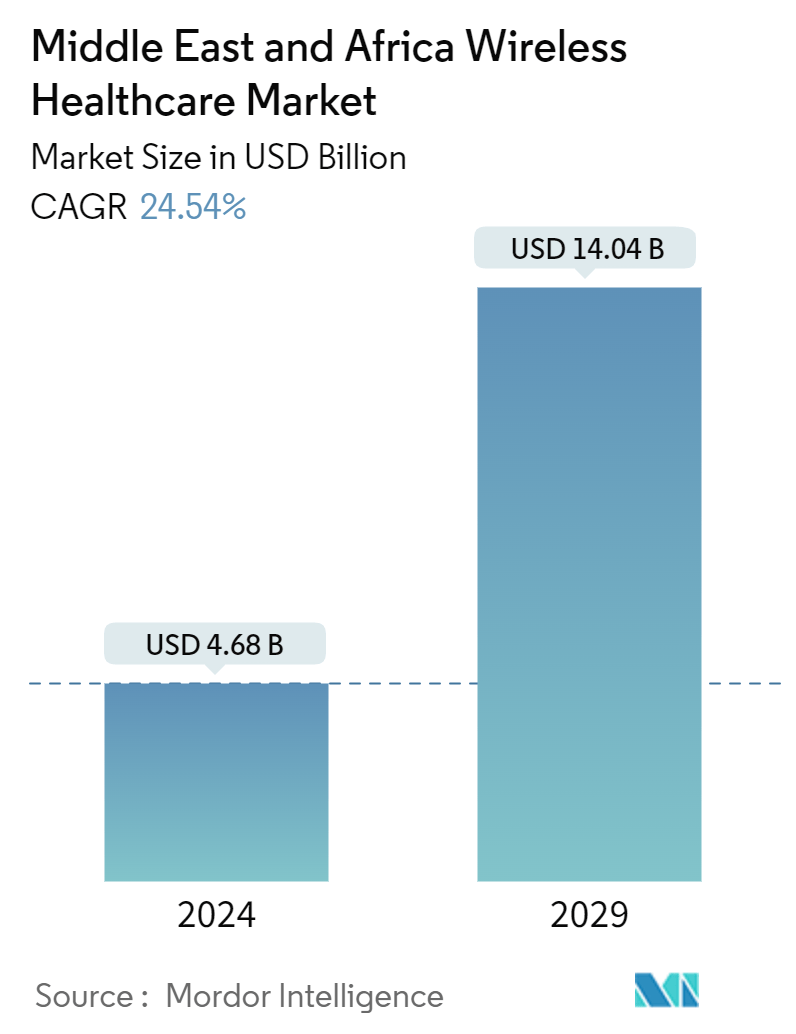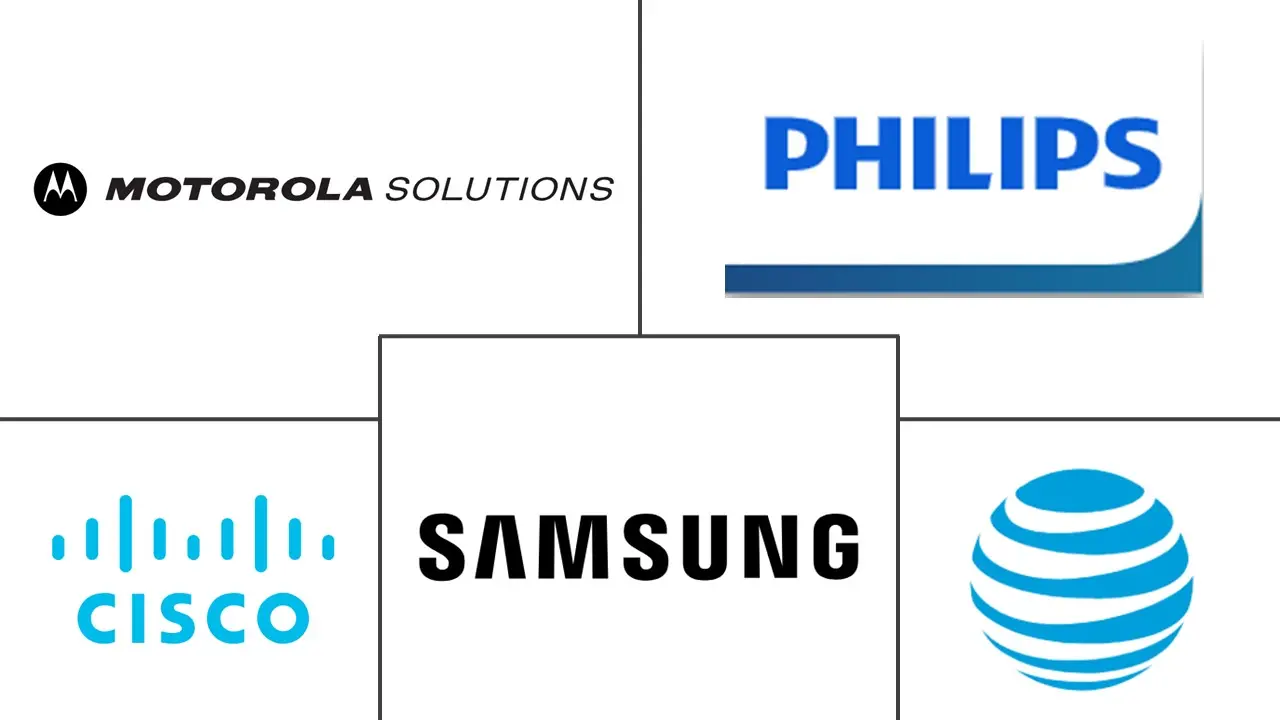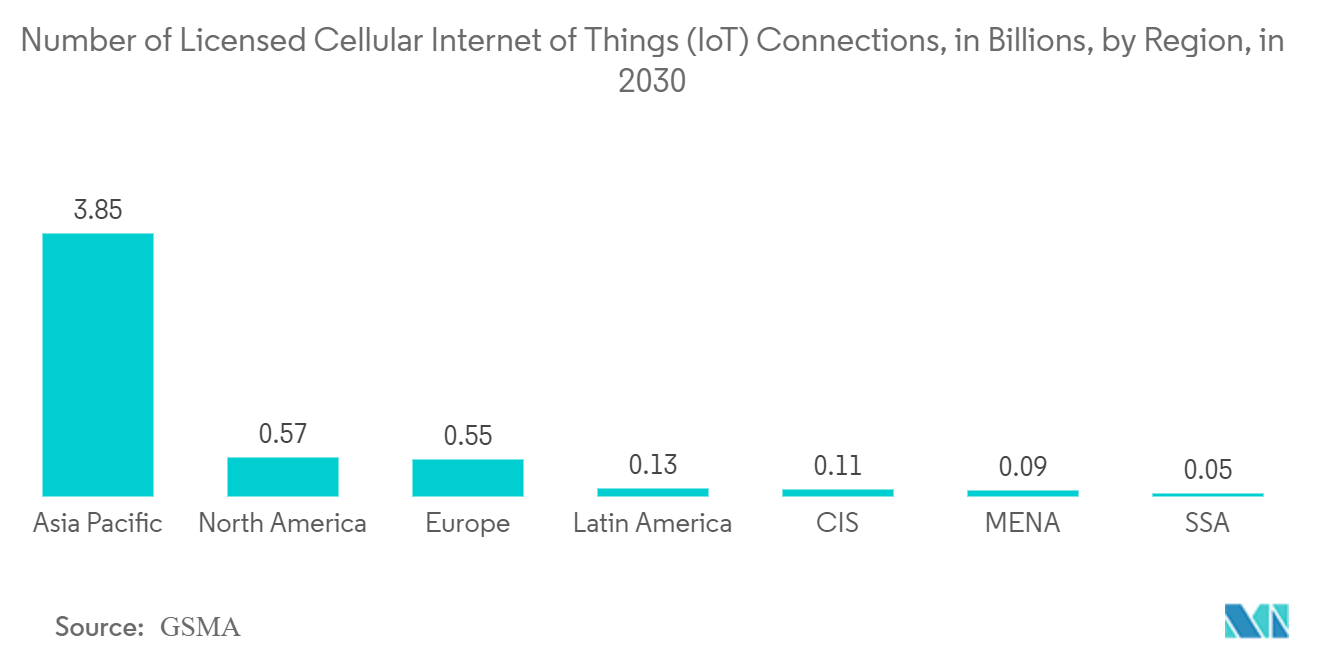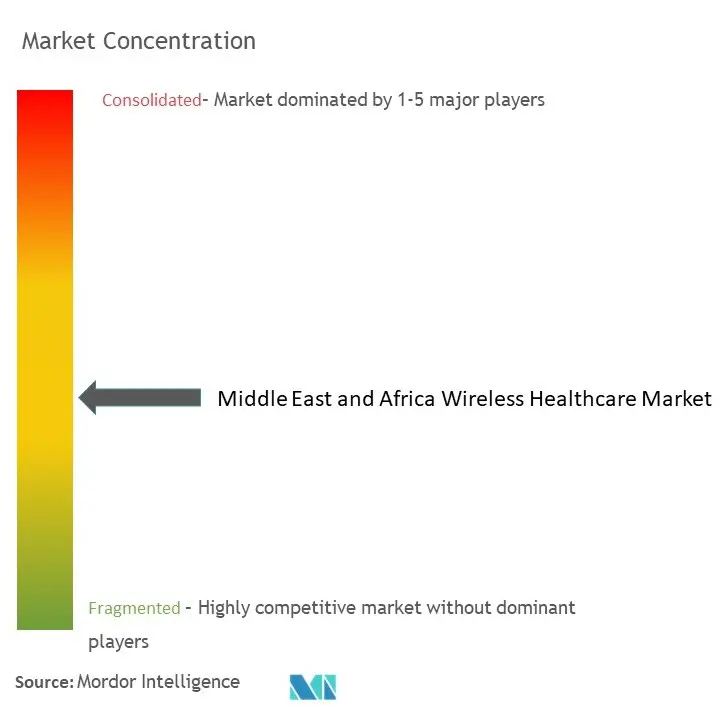Middle East & Africa Wireless Healthcare Market Size

| Study Period | 2019 - 2029 |
| Base Year For Estimation | 2023 |
| Market Size (2024) | USD 4.68 Billion |
| Market Size (2029) | USD 14.04 Billion |
| CAGR (2024 - 2029) | 24.54 % |
| Market Concentration | Low |
Major Players
*Disclaimer: Major Players sorted in no particular order |
Middle East & Africa Wireless Healthcare Market Analysis
The Middle East And Africa Wireless Healthcare Market size is estimated at USD 4.68 billion in 2024, and is expected to reach USD 14.04 billion by 2029, growing at a CAGR of 24.54% during the forecast period (2024-2029).
- The Middle East and Africa wireless healthcare market has experienced significant growth in recent years, driven by several factors, such as technological advancements, growing healthcare expenditures, and increasing adoption of digital health solutions.
- The prevalence of chronic diseases such as diabetes, cardiovascular diseases, and respiratory disorders is on the rise in the Middle East and Africa. Wireless healthcare technologies enable continuous monitoring of patient's health parameters, early detection of complications, and timely intervention, thereby improving patient outcomes.
- The increasing adoption of connected devices in healthcare is a significant driver propelling the growth of the wireless healthcare market in the Middle East and Africa. Connected devices such as wearable health trackers, smartwatches, and other sensor-based gadgets allow remote monitoring of patient's vital signs and health parameters.
- Growing technological advancements are driving the expansion of the wireless healthcare market in the region. Advancements in technology, such as the Internet of Things (IoT), artificial intelligence (AI), and wearable devices, enable the development of innovative wireless healthcare solutions. These solutions range from wearable health trackers and remote patient monitoring devices to telemedicine platforms and virtual health assistants.
- The lack of robust networking infrastructure poses a significant constraint to the growth of wireless healthcare in the market. Healthcare providers face challenges in transmitting patient data, conducting telemedicine consultations, and accessing cloud-based healthcare platforms essential for remote monitoring and management of patient's health.
- The COVID-19 pandemic prompted a surge in demand for remote healthcare solutions to minimize the risk of virus transmission in healthcare systems. Wireless healthcare technologies such as telemedicine platforms, remote patient monitoring devices, and mobile health applications experienced heightened adoption as patients sought virtual consultations and remote monitoring services.
Middle East & Africa Wireless Healthcare Market Trends
Home Care Application Segment is Expected to Hold Significant Market Share
- The home care application segment in the Middle East and Africa wireless healthcare market encompasses a variety of technologies and services designed to facilitate healthcare delivery and monitoring within the home environment.
- As per the International Trade Administration, the US Department of Commerce, Saudi Arabia leads in healthcare spending among the GCC (Gulf Cooperation Council) countries, with the sector being a key focus for the Saudi Government. In 2023, the country allocated USD 50.4 billion for healthcare and social development, which constitutes 16.96% of its total budget.
- Remote patient monitoring solutions enable healthcare providers to remotely monitor patients' health status and vital signs from their homes using wireless devices such as wearable sensors, connected medical devices, and mobile health apps. Patients can transmit data such as blood pressure, heart rate, blood glucose levels, and activity levels to healthcare professionals in real-time, allowing timely interventions and adjustments to treatment plans.
- According to GSMA, the cellular Internet of Things (IoT) market is predicted to reach 5.3 billion connections by 2030. With about 9 million connections in 2030, the Middle East and Africa region is expected to be the leading market.
- Home care applications include medication management tools that help patients adhere to their medication schedules and dosage regimens. These apps may provide medication reminders, dosage instructions, pill identification, and medication adherence tracking features to help patients manage their medications effectively and avoid missed doses.

Saudi Arabia is Expected to Hold Significant Market Share
- The Saudi government has been actively promoting digital health initiatives and investing in healthcare infrastructure to improve the quality and accessibility of healthcare services. Initiatives such as the Saudi Vision 2030, which aims to enhance healthcare delivery through digital transformation, are driving the adoption of wireless healthcare solutions.
- Under Vision 2030, the Saudi Arabian Government intends to invest over USD 65 billion to develop the country's healthcare infrastructure, reorganize and privatize health services and insurance, launch 21 "health clusters" throughout the country, and expand the provision of e-health services.
- The basic health coverage among adults in Saudi Arabia encompasses access to essential healthcare services provided through primary healthcare centers, hospitals, and specialized medical facilities. According to the General Authority for Statistics (Saudi Arabia), in 2023, 58% of Saudi adults had some form of government health coverage.
- Saudi Arabia boasts a well-developed telecommunications infrastructure and high smartphone penetration rates, creating an ideal environment for adopting wireless healthcare technologies. Advancements in wearable devices, telemedicine platforms, and health informatics fuel innovation in the market.
- Due to social distancing measures and the need for contactless services, the COVID-19 pandemic accelerated the adoption of digital health solutions, health devices, and pharmacy delivery apps. The government's initiatives to promote digital transformation in the healthcare sector further fuel the market's growth.

Middle East & Africa Wireless Healthcare Industry Overview
The Middle East and Africa wireless healthcare market is semi-consolidated with the presence of major players like Cisco Systems Inc., Motorola Solutions Inc., Samsung Electronics Co. Ltd, AT&T Inc., and Koninklijke Philips NV. Players in the market are adopting strategies such as partnerships and acquisitions to enhance their product offerings and gain sustainable competitive advantage. For instance,
- In March 2024, Royal Philips, one of the prominent players in health technology, announced an expanded collaboration with Amazon Web Services (AWS) to address the growing need for secure and scalable digital pathology solutions in the cloud. Royal Philips and AWS will advance digital pathology and assist pathology labs in efficiently storing, managing, and analyzing growing volumes of digital pathology data, enabling more pathology labs to adopt digital workflows to increase productivity. In addition, pathology labs could optimize workflow efficiency and facilitate collaboration among specialists, enabling seamless integration with existing healthcare systems to deliver holistic patient care.
- In January 2024, Extreme Networks and Cloud Solutions, one of the leading providers of healthcare IT services, announced the expansion of their partnership, enabling cloud solutions customers to leverage advanced wireless and fabric networking solutions from Extreme to better support modernized patient care in Saudi Arabia.
Middle East & Africa Wireless Healthcare Market Leaders
-
Cisco Systems Inc.
-
Motorola Solutions Inc.
-
Samsung Electronics Co. Ltd
-
AT&T Inc.
-
Koninklijke Philips NV
*Disclaimer: Major Players sorted in no particular order

Middle East & Africa Wireless Healthcare Market News
- February 2024: HCLTech, one of the leading global technology companies, launched FlexSpace 5G, an advanced digital workplace experience-as-a-service that boosts efficiency and security for global businesses. HCLTech FlexSpace 5G carries individual benefits for businesses. It delivers fast and more dependable connectivity, offering advantages for various sectors, including financial services, technology, life sciences, healthcare, telecom, media, and entertainment.
- February 2024: At Arab Health 2024, United Imaging partnered with various healthcare and technology companies, including Prepaire Labs, a biotechnology company developing drug discovery and personalized medicine. United Imaging also forged a substantial partnership agreement with Al Mana Group, a pioneer in the field of healthcare in Saudi Arabia.
Middle East And Africa Wireless Healthcare Market Report - Table of Contents
1. INTRODUCTION
- 1.1 Study Assumptions and Market Definition
- 1.2 Scope of the Study
2. RESEARCH METHODOLOGY
3. EXECUTIVE SUMMARY
4. MARKET DYNAMICS
- 4.1 Market Overview
- 4.2 Industry Value Chain Analysis
-
4.3 Industry Attractiveness - Porter's Five Forces Analysis
- 4.3.1 Bargaining Power of Suppliers
- 4.3.2 Bargaining Power of Consumers
- 4.3.3 Threat of New Entrants
- 4.3.4 Intensity of Competitive Rivalry
- 4.3.5 Threat of Substitute Products
-
4.4 Technology Snapshot
- 4.4.1 Wireless Personal Area Network (WPAN)
- 4.4.2 Wi-Fi
- 4.4.3 Worldwide Interoperability for Microwave Access (WiMAX)
- 4.4.4 Wireless Wide Area Network (WWAN)
-
4.5 Market Drivers
- 4.5.1 Increasing Adoption of Connected Devices in Healthcare
- 4.5.2 Growing Technological Advancements
-
4.6 Market Restraints
- 4.6.1 Lack of Networking Infrastructure
- 4.7 Assessment of COVID-19 impact on the Market
5. MARKET SEGMENTATION
-
5.1 By Component
- 5.1.1 Hardware
- 5.1.2 Software
- 5.1.3 Services
-
5.2 By Application
- 5.2.1 Hospitals and Nursing Homes
- 5.2.2 Home Care
- 5.2.3 Pharmaceuticals
-
5.3 By Country
- 5.3.1 Saudi Arabia
- 5.3.2 United Arab Emirates
- 5.3.3 South Africa
- 5.3.4 Israel
6. COMPETITIVE LANDSCAPE
-
6.1 Company Profiles*
- 6.1.1 Cisco Systems Inc.
- 6.1.2 Motorola Solutions Inc.
- 6.1.3 Samsung Electronics Co. Ltd
- 6.1.4 AT&T Inc.
- 6.1.5 Koninklijke Philips NV
- 6.1.6 Extreme Networks Inc.
- 6.1.7 Qualcomm Technologies Inc.
- 6.1.8 Verizon Communication Inc.
- 6.1.9 Apple Inc.
- 6.1.10 Allscripts Healthcare Solutions Inc.
7. INVESTMENT ANALYSIS
8. FUTURE OF THE MARKET
** Subject To AvailablityMiddle East & Africa Wireless Healthcare Industry Segmentation
Wireless healthcare incorporates wireless technology into traditional medicine, such as disease diagnosis, monitoring, and treatment, as well as additional technologies that can assist individuals in improving their health and wellness. Wireless healthcare ensures the accuracy of real-time documentation, lowers consumer expenses, offers access to real-time patient records, and enables real-time monitoring of patients' conditions even remotely.
The Middle East and Africa wireless healthcare market is segmented by component (hardware, software, and services), application (hospitals and nursing homes, home care, and pharmaceuticals), and country (Saudi Arabia, United Arab Emirates, South Africa, and Israel). The market sizes and forecasts are provided in terms of value (USD) for all the above segments.
| By Component | Hardware |
| Software | |
| Services | |
| By Application | Hospitals and Nursing Homes |
| Home Care | |
| Pharmaceuticals | |
| By Country | Saudi Arabia |
| United Arab Emirates | |
| South Africa | |
| Israel |
Middle East And Africa Wireless Healthcare Market Research FAQs
How big is the Middle East And Africa Wireless Healthcare Market?
The Middle East And Africa Wireless Healthcare Market size is expected to reach USD 4.68 billion in 2024 and grow at a CAGR of 24.54% to reach USD 14.04 billion by 2029.
What is the current Middle East And Africa Wireless Healthcare Market size?
In 2024, the Middle East And Africa Wireless Healthcare Market size is expected to reach USD 4.68 billion.
Who are the key players in Middle East And Africa Wireless Healthcare Market?
Cisco Systems Inc., Motorola Solutions Inc., Samsung Electronics Co. Ltd, AT&T Inc. and Koninklijke Philips NV are the major companies operating in the Middle East And Africa Wireless Healthcare Market.
What years does this Middle East And Africa Wireless Healthcare Market cover, and what was the market size in 2023?
In 2023, the Middle East And Africa Wireless Healthcare Market size was estimated at USD 3.53 billion. The report covers the Middle East And Africa Wireless Healthcare Market historical market size for years: 2019, 2020, 2021, 2022 and 2023. The report also forecasts the Middle East And Africa Wireless Healthcare Market size for years: 2024, 2025, 2026, 2027, 2028 and 2029.
Middle East And Africa Wireless Healthcare Industry Report
Statistics for the 2024 Middle East and Africa Wireless Healthcare market share, size and revenue growth rate, created by Mordor Intelligence™ Industry Reports. Middle East and Africa Wireless Healthcare analysis includes a market forecast outlook to 2029 and historical overview. Get a sample of this industry analysis as a free report PDF download.



